Diffraction-Limited, High-Precision Aspheres: MRF Polished
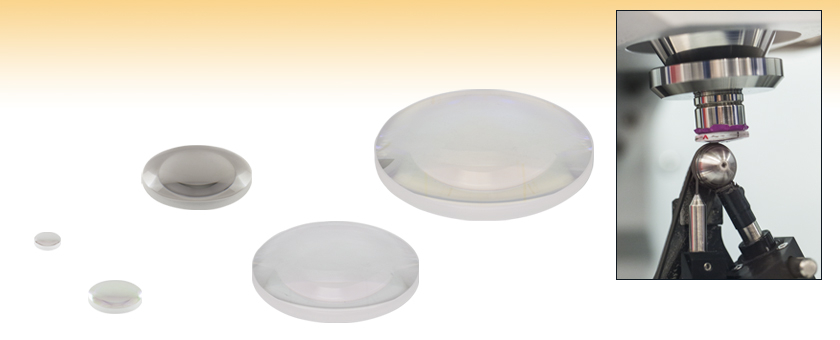
- N-BK7 or S-LAH64 Aspheric Lenses with Diffraction-Limited Performance
- Uncoated or AR Coated Options Available
- Available in Ø12.5 mm, Ø25.0 mm, Ø50.0 mm, Ø75.0 mm, or Ø100.0 mm
- Numerical Apertures of 0.20, 0.21, or 0.52
Our QED Technologies Magnetorheological Finishing (MRF) Polisher corrects any remaining defects from the CNC grinding and polishing processes.
AL1225G
Ø12.5 mm
AL2550J-C
Ø25.0 mm
AL50100H-B
Ø50.0 mm
AL100200H-B
Ø100.0 mm
AL75150H
Ø75.0 mm

Please Wait
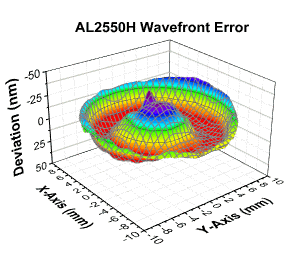
Click for Details
The deviation from an ideal transmitted wavefront for an AL2550H aspheric lens is shown above; for this sample the deviation is no more than 55 nm. To see how this compares to other lens types, see the Lens Comparison tab.
| Click on the red Document icon next to the item numbers below to access the Zemax file download. Our entire Zemax Catalog is also available. |
| Common Specificationsa | |
|---|---|
| Outer Diameter Tolerance | +0.00 / -0.05 mm |
| Substrate | N-BK7b or S-LAH64b |
| Numerical Aperturec | N-BK7: 0.20d / 0.21e S-LAH64: 0.52 |
| f/#c | N-BK7: 2.0 S-LAH64: 0.8 |
| Refractive Index | N-BK7: 1.517f or S-LAH64: 1.788f |
| Surface Qualityc | 40-20 Scratch-Dig |
| Aspheric Surface Accuracyc | <55 nm |
| Slope Error (PV)c | <200 µradian |
| Centrationc | <1 arcmin |
Features
- High Strehl Ratio: >0.80
- Seven Diameter/Focal Length Combinations:
- Ø12.5 mm / f = 25.0 mm
- Ø25.0 mm / f = 20.0 mm
- Ø25.0 mm / f = 50.0 mm
- Ø50.0 mm / f = 40.0 mm
- Ø50.0 mm / f = 100.0 mm
- Ø75.0 mm / f = 150.0 mm
- Ø100.0 mm / f = 200.0 mm
- Three Design Wavelengths: 532 nm, 780 nm, or 1310 nm
- Ideal for Diffraction-Limited Collimation and Coupling
Thorlabs offers aspheric lenses that provide true, diffraction-limited performance for on-axis beam focusing and collimation. This is achieved by a combination of Computer Numerical Controlled (CNC) machine polishing and high-precision Magnetorheological Finishing (MRF). For monochromatic sources, spherical aberration is often what prevents a single spherical lens from achieving diffraction-limited performance when focusing or collimating light. The lenses found on this page are free of such aberrations, and offer the best single-element solution for many on-axis applications including collimating the output of a fiber, coupling light into a fiber, spatial filtering, or imaging light onto a detector. Our high-precision aspheric lenses achieve Strehl ratios of >0.80, the highest of any Thorlabs lens. The Ø12.5 mm, Ø25.0 mm, and Ø50.0 mm N-BK7 aspheres achieve this Strehl ratio at discrete wavelengths from 350 - 2000 nm or 400 - 2000 nm. The Ø75.0 mm and Ø100.0 mm N-BK7 aspheres as well as the S-LAH64 aspheres achieve this Strehl ratio at 780 nm.
Our high-precision aspheres are available as Ø12.5 mm, Ø25.0 mm, Ø50.0 mm, Ø75.0 mm, or Ø100.0 mm N-BK7 lenses; or as Ø25.0 mm or Ø50.0 mm S-LAH64 lenses. Both substrates offer high transmission from the visible through the NIR (see the Info Icons below for transmission data). However, since S-LAH64 has a higher index of refraction than N-BK7, it is commonly used to fabricate high-NA, short-focal-length lenses. The lenses below are offered uncoated or AR-coated for 350 nm - 700 nm, 650 nm - 1050 nm, or 1050 nm - 1700 nm. Uncoated lenses are shaped for a 532 nm, 780 nm, or 1310 nm design wavelength, while the AR-coated lenses feature the design wavelength closest to the center of the coating range. For example, the AL1225G-A is shaped for a design wavelength of 532 nm and its AR coating is for 350 nm - 700 nm.
If an unmounted aspheric lens is being used to collimate the light from a point source or laser diode, the side with the greater radius of curvature (i.e., the flatter surface) should face the point source or laser diode. Note that the numerical aperture of your lens should be greater than or equal to the numerical aperture of the light source.
Superior Optical Performance
In order to reach diffraction-limited performance, a lens must meet two criteria: it must be designed to eliminate aberrations and the design must be executed without any manufacturing errors distorting the wavefront. To the upper right is a contour plot displaying the deviation from an ideal transmitted wavefront for an AL2550H aspheric lens. With less than 55 nm aspheric surface accuracy, our Diffraction-Limited, MRF-Polished line of Aspheric Lenses has the lowest wavefront error of any of our other imaging optics. For more information on how these lenses perform compared to our other lines, see the Lens Comparison tab.
Optical Performance Verification
Each lens undergoes in-process verification in order to achieve optimum performance. This is handled primarily by the Zygo Verifire™ Asphere Interferometry Metrology Station. All of our polishing machines have software which communicates with our metrology, allowing fast, accurate, and consistent adjustments to our aspheric lenses. Metrology data can be provided on request; contact Tech Support with inquiries.
Custom Aspheric Lenses
Thorlabs' diffraction-limited, high-precision aspheric lenses are manufactured at the production facility housed in our headquarters in Newton, NJ. Our optics business unit has a wide breadth of manufacturing capabilities that allow us to offer a variety of custom optics for both OEM sales and low quantity one-off orders. Custom lens diameters, focal lengths, substrates, coatings, and mounting options are available with prices that are comparable to our stock offerings. For more information, please see the Custom Capabilities tab or contact Tech Support to inquire about a custom order.
All of these high precision aspheres can be ordered uncoated or with one of the following broadband AR coatings: 350 - 700 nm (designated as -A), 650 - 1050 nm (designated as -B), or 1050 - 1700 nm (designated as -C).
Transmission Data for S-LAH64 and N-BK7 Substrates
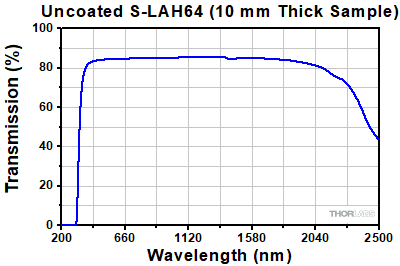
Click to Enlarge
Click Here for Raw Data
The graph above shows the transmission of a 10 mm thick S-LAH64 substrate.
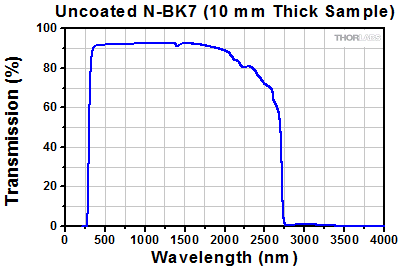
Click to Enlarge
Click Here for Raw Data
The graph above shows the transmission of a 10 mm thick N-BK7 substrate.
Reflectance Data for AR-Coated Lenses
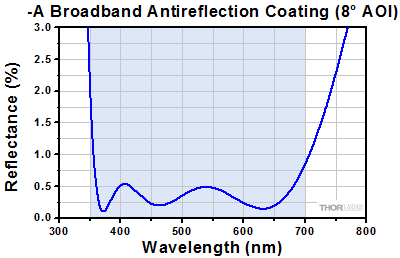
Click to Enlarge
Click Here for Raw Data
The blue shaded region indicates the specified 350 - 700 nm wavelength range where the specifications are guaranteed.
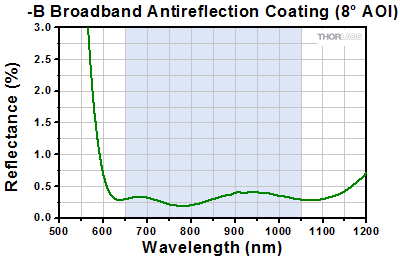
Click to Enlarge
Click Here for Raw Data
The blue shaded region indicates the specified 650 - 1050 nm wavelength range where the specifications are guaranteed.
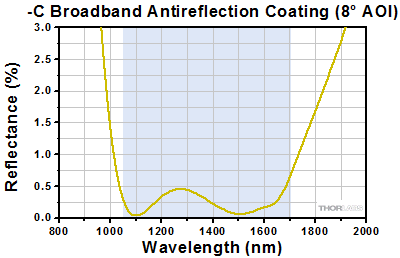
Click to Enlarge
Click Here for Raw Data
The blue shaded region indicates the specified 1050 - 1700 nm wavelength range where the specifications are guaranteed.
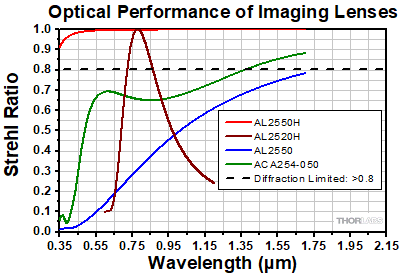
Click for Details
Above is a graph of the measured Strehl ratio of Our Diffraction-Limited
Aspheres (Item #s AL2550H and AL2520H), a CNC-Polished Asphere (Item # AL2550), and an Air-spaced Spherical Doublet (ACA254-050 series).
Diffraction Limited Performance
While all of our aspheric lenses are machined based on a diffraction-limited design (i.e., the ability to resolve an image is at its physical limit), traditional CNC grinding techniques use grinding wheels and curved grinding bits that cannot achieve the fine detail needed to reduce the physical deformities in an aspheric lens' surface to the diffraction-limited design. This limitation can be overcome using Magnetorheological Finishing (MRF) technology. The technique uses a ferrofluid band run along a magnetic wheel to dynamically remove material from the surface of a lens, allowing nearly all surface defects to be removed from an aspheric lens’ surface. Thorlabs uses MRF technology to produce a line of diffraction-limited (Strehl ratio > 0.80), high-precision aspheres with the lowest wavefront error of any of our lenses.
The Strehl Ratio is the peak intensity of the point spread function (PSF) generated by an optic or optical system divided by the peak intensity of the point spread function (PSF) of the same optic or system in the absence of aberrations inherent to the optical design or induced by manufacturing processes. When this ratio is above 0.8, the optic is widely considered diffraction limited. That is to say, the optic's only limitation in imaging resolution is the Airy Disk that has a size determined by the diameter of the lens; trying to resolve anything smaller than this Airy Disk will cause diffraction error in the images created by the lens. The Airy Disk's first fringe can be calculated by sinΘ ≈ 1.22 (λ/d), where λ is the wavelength of light focused by the lens, d is the diameter of the lens, and Θ is the angle created in radians. The graph to the right shows the Strehl ratio of MRF-Polished Aspheric Lenses compared to a CNC-Polished Aspheric Lens and a Spherical Doublet.
Shown below are on-axis interferometer scans of a selection of our imaging optics, all about Ø20 mm, showing their wavefront error. Wavefront error is a measure of how much the sum of the physical defects in an optic change a wavefront passing through it, as compared to the same wavefront's shape if it has passed through an ideal optic of the same design. This difference between ideal and measured performance is shown by the changes in color in the contour maps, all of which share the same scaling. All of the optics tested here performed within our specifications, but the AL2550H performed with the lowest wavefront error. This AL2550H in particular achieved a wavefront error of ±0.05 µm.
It is worth noting that imaging is best determined by a combination of wavefront error and optical design. At first glance, it may appear that the AL2550 is the worst optic listed on this tab, due to the high fluctuation in wavefront error, but recall that wavefront error is the deviation from an optic with no defects. Though the AL2550 in this example has a deviation of about ±0.25 µm, aspheric lenses on the whole do not distort light as much as spherical lenses. This is because aspheric lenses are designed to minimize imaging aberrations, while spherical lenses are not. This means that a perfect spherical lens with no wavefront error will never resolve an image as cleanly as a properly designed aspheric lens without any wavefront error. For more information on the different types of lenses that Thorlabs makes, visit our Lens Tutorial page.
Custom Aspheric Lenses
Key Capabilities
- Custom Lens Diameters, Focal Lengths, Substrates, Coatings, and Mounting Options
- Enhanced Specifications and Tighter Tolerances than Stock Optics
- Support for OEM Sales and Low-Quantity Special Orders
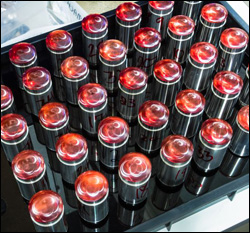
Click to Enlarge
A production lot of aspheric lenses that are ready for polishing at our headquarters in Newton, NJ.
Our in-house production capabilities allow us to offer a wide variety of custom CNC-polished and MRF-polished aspheric lenses. The diameter, focal length, conjugate ratio, substrate material, and coating of these optics can all be customized to meet the unique performance requirements of a given application. In addition, custom optics can be ordered with tighter tolerances and better specifications than our stock offerings. Because of our vertically integrated manufacturing process, these custom lenses are available for both OEM sales and individual low-quantity orders.
For the production of aspheric lenses, we have a CNC cell with Satisloh grinders and polishers, a QED Q-flex 100 for low wavefront error polishing, and a Satisloh C-25L for centration and custom shaping. The grinding and polishing machines allow us to manufacture both spherical and aspheric lenses with diameters from 10 mm (0.39") to 150 mm (5.91") (please contact Tech Support with inquiries about even larger lenses). The centration machine can achieve centration down to 5 arcseconds, which is much tighter than the tolerance on most of our stock optics, and can also be used to create optics with custom shapes.
We are generally able to produce custom aspheric lenses with short lead times. For modifications to an existing part, delivery in one week is standard. For custom shapes and long focal length optics, a 6-8 week lead time is typical. To receive more information or a quote for a custom optic, please contact Tech Support.
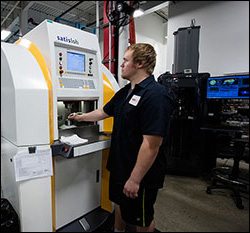
Click to Enlarge
An operator loading a Satisloh Centration Machine for stock aspheric optics and custom Lens Shapes.
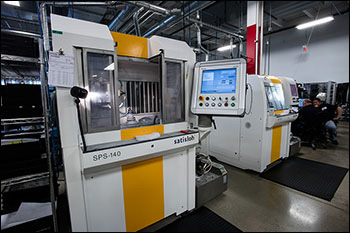
Click to Enlarge
Satisloh Grinder for Aspheric Lenses
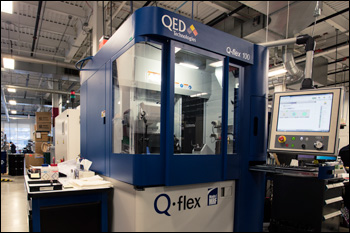
Click to Enlarge
QED Technologies Magnetorheological Finishing (MRF) Polisher
Our engineers are available to help manufacture optics for your application.
Customs are available for both OEM sales and individual low-quantity orders.
Please contact techsupport@thorlabs.com with your custom optic requests.
Aspheric Lens Metrology
Key Capabilities
- In Process Metrology for All MRF- and CNC-Polished Aspheres
- Non-Contact Interferometric and Non-Marring Profilometer Measurements
- Test Datasheets Available for OEM Sales and Custom Orders
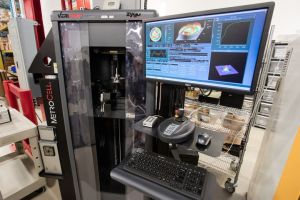
Click to Enlarge
Zygo Verifire™ Asphere Interferometer Metrology Station
In order to ensure that the specifications for our MRF- and CNC-Polished aspheric lenses are continuously met, we utilize a variety of advanced metrology equipment for in-process measurements of lens shape, surface roughness, and transmitted wavefront error. First, a non-contact Zygo Verifire™ Asphere Interferometer is utilized to verify the surface profile of the lenses. This instrument operates as a Fizeau interferometer by varying the distance between a reference flat or sphere (consistent with ISO 10110-12 standards) and the optic under test. Reflections from each optical surface produce an interference pattern that is recorded by the diagnostic, resulting in measurements of the low-spatial-frequency components of the aspheric surface profile.
An example of a surface irregularity measurement performed by a Zygo Verifire™ interferometer (λ = 633 nm) is shown below. It contains interference fringes at points where the surface profile of the reference does not match the finished asphere. The relatively smooth fringe profile across the >22 mm clear aperture of the lens (shown by the lineouts in the bottom left) demonstrates the extremely low sag deviation and surface irregularity of our lenses. The lens tested here has an exceptionally low RMS surface irregularity of 0.428 fringes over its entire clear aperture and a significantly better value around the center of the lens.
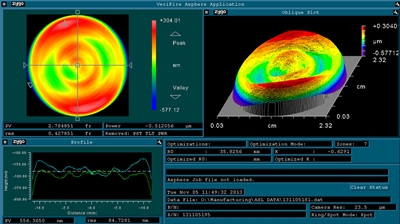
Click to Enlarge
Zygo Verifire™ Asphere Interferometer Results
Complementary measurements of each optic's high-spatial-frequency surface roughness are then made with a Zygo NewView™ white light interferometer. This device operates with a reference in one arm of the interferometer and the aspheric optic in the other. The length of one arm is varied, resulting in a white light interferogram that carries information about finer details of the optical surface. Once the surface profile of an optic has been verified, a Zygo GPI LC™ interferometer is utilized to make measurements of the transmitted wavefront error through the lens. This test ensures that the bulk of the optic is free from defects and the rear surface of the lens is flat.
To further improve our metrology capabilities, a PGI Dimension 5XL profilometer has also been added to our lens cell. This instrument makes precision contact measurements by dragging a small stylus over the surface of an optic, resulting in a complete characterization of the surface profile. This method is extremely versatile, and it can be applied to optics with a high numerical aperture or large diameter that are unsuitable for interferometric measurements. As a result, we are able to produce custom aspheric lenses with specifications that significantly exceed the capabilities of other optics manufacturers.
Taken together, these interferometric and contact measurements produce a complete set of three-dimensional data for each aspheric lens. This detailed quality control information allows us to manufacture the highest quality of aspheres and maintain our specifications with an extremely high degree of confidence. The metrology results for each polished aspheric lens can be compiled into a test data sheet upon request.
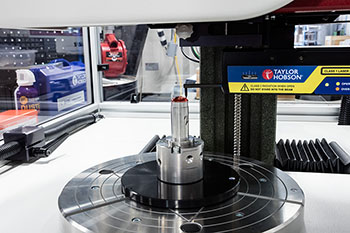
Click to Enlarge
PGI Dimension 5XL Profilometer Measuring an Aspheric Lens
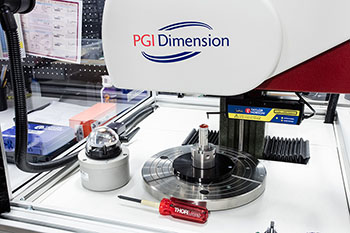
Click to Enlarge
A PGI Dimension 5XL Profilometer allows for the production of large-diameter and high-numerical-aperture aspheric lenses, such as the piece to the left of the instrument.
| N-BK7 Damage Threshold Specifications | |
|---|---|
| Coating Designation (Item # Suffix) |
Damage Threshold |
| -A | 7.5 J/cm2 at 532 nm, 10 ns, 10 Hz, Ø0.504 mm |
| -B | 7.5 J/cm2 at 810 nm, 10 ns, 10 Hz, Ø0.144 mm |
| -C | 7.5 J/cm2 at 1542 nm, 10 ns, 10 Hz, Ø0.123 mm |
| S-LAH64 Damage Threshold Specifications | |
|---|---|
| Coating Designation (Item # Suffix) |
Damage Threshold |
| -B | 7.5 J/cm2 at 810 nm, 10 ns, 10 Hz, Ø0.155 mm |
Damage Threshold Data for Thorlabs' AR-Coated N-BK7 and S-LAH64 Aspheres
The specifications to the right are measured data for Thorlabs' AR-Coated, High-Precision Aspheric Lenses. Damage threshold specifications are constant for a given coating type and substrate combination, regardless of the size of the lens.
Laser Induced Damage Threshold Tutorial
The following is a general overview of how laser induced damage thresholds are measured and how the values may be utilized in determining the appropriateness of an optic for a given application. When choosing optics, it is important to understand the Laser Induced Damage Threshold (LIDT) of the optics being used. The LIDT for an optic greatly depends on the type of laser you are using. Continuous wave (CW) lasers typically cause damage from thermal effects (absorption either in the coating or in the substrate). Pulsed lasers, on the other hand, often strip electrons from the lattice structure of an optic before causing thermal damage. Note that the guideline presented here assumes room temperature operation and optics in new condition (i.e., within scratch-dig spec, surface free of contamination, etc.). Because dust or other particles on the surface of an optic can cause damage at lower thresholds, we recommend keeping surfaces clean and free of debris. For more information on cleaning optics, please see our Optics Cleaning tutorial.
Testing Method
Thorlabs' LIDT testing is done in compliance with ISO/DIS 11254 and ISO 21254 specifications.
First, a low-power/energy beam is directed to the optic under test. The optic is exposed in 10 locations to this laser beam for 30 seconds (CW) or for a number of pulses (pulse repetition frequency specified). After exposure, the optic is examined by a microscope (~100X magnification) for any visible damage. The number of locations that are damaged at a particular power/energy level is recorded. Next, the power/energy is either increased or decreased and the optic is exposed at 10 new locations. This process is repeated until damage is observed. The damage threshold is then assigned to be the highest power/energy that the optic can withstand without causing damage. A histogram such as that below represents the testing of one BB1-E02 mirror.

The photograph above is a protected aluminum-coated mirror after LIDT testing. In this particular test, it handled 0.43 J/cm2 (1064 nm, 10 ns pulse, 10 Hz, Ø1.000 mm) before damage.

| Example Test Data | |||
|---|---|---|---|
| Fluence | # of Tested Locations | Locations with Damage | Locations Without Damage |
| 1.50 J/cm2 | 10 | 0 | 10 |
| 1.75 J/cm2 | 10 | 0 | 10 |
| 2.00 J/cm2 | 10 | 0 | 10 |
| 2.25 J/cm2 | 10 | 1 | 9 |
| 3.00 J/cm2 | 10 | 1 | 9 |
| 5.00 J/cm2 | 10 | 9 | 1 |
According to the test, the damage threshold of the mirror was 2.00 J/cm2 (532 nm, 10 ns pulse, 10 Hz, Ø0.803 mm). Please keep in mind that these tests are performed on clean optics, as dirt and contamination can significantly lower the damage threshold of a component. While the test results are only representative of one coating run, Thorlabs specifies damage threshold values that account for coating variances.
Continuous Wave and Long-Pulse Lasers
When an optic is damaged by a continuous wave (CW) laser, it is usually due to the melting of the surface as a result of absorbing the laser's energy or damage to the optical coating (antireflection) [1]. Pulsed lasers with pulse lengths longer than 1 µs can be treated as CW lasers for LIDT discussions.
When pulse lengths are between 1 ns and 1 µs, laser-induced damage can occur either because of absorption or a dielectric breakdown (therefore, a user must check both CW and pulsed LIDT). Absorption is either due to an intrinsic property of the optic or due to surface irregularities; thus LIDT values are only valid for optics meeting or exceeding the surface quality specifications given by a manufacturer. While many optics can handle high power CW lasers, cemented (e.g., achromatic doublets) or highly absorptive (e.g., ND filters) optics tend to have lower CW damage thresholds. These lower thresholds are due to absorption or scattering in the cement or metal coating.

LIDT in linear power density vs. pulse length and spot size. For long pulses to CW, linear power density becomes a constant with spot size. This graph was obtained from [1].

Pulsed lasers with high pulse repetition frequencies (PRF) may behave similarly to CW beams. Unfortunately, this is highly dependent on factors such as absorption and thermal diffusivity, so there is no reliable method for determining when a high PRF laser will damage an optic due to thermal effects. For beams with a high PRF both the average and peak powers must be compared to the equivalent CW power. Additionally, for highly transparent materials, there is little to no drop in the LIDT with increasing PRF.
In order to use the specified CW damage threshold of an optic, it is necessary to know the following:
- Wavelength of your laser
- Beam diameter of your beam (1/e2)
- Approximate intensity profile of your beam (e.g., Gaussian)
- Linear power density of your beam (total power divided by 1/e2 beam diameter)
Thorlabs expresses LIDT for CW lasers as a linear power density measured in W/cm. In this regime, the LIDT given as a linear power density can be applied to any beam diameter; one does not need to compute an adjusted LIDT to adjust for changes in spot size, as demonstrated by the graph to the right. Average linear power density can be calculated using the equation below.

The calculation above assumes a uniform beam intensity profile. You must now consider hotspots in the beam or other non-uniform intensity profiles and roughly calculate a maximum power density. For reference, a Gaussian beam typically has a maximum power density that is twice that of the uniform beam (see lower right).
Now compare the maximum power density to that which is specified as the LIDT for the optic. If the optic was tested at a wavelength other than your operating wavelength, the damage threshold must be scaled appropriately. A good rule of thumb is that the damage threshold has a linear relationship with wavelength such that as you move to shorter wavelengths, the damage threshold decreases (i.e., a LIDT of 10 W/cm at 1310 nm scales to 5 W/cm at 655 nm):

While this rule of thumb provides a general trend, it is not a quantitative analysis of LIDT vs wavelength. In CW applications, for instance, damage scales more strongly with absorption in the coating and substrate, which does not necessarily scale well with wavelength. While the above procedure provides a good rule of thumb for LIDT values, please contact Tech Support if your wavelength is different from the specified LIDT wavelength. If your power density is less than the adjusted LIDT of the optic, then the optic should work for your application.
Please note that we have a buffer built in between the specified damage thresholds online and the tests which we have done, which accommodates variation between batches. Upon request, we can provide individual test information and a testing certificate. The damage analysis will be carried out on a similar optic (customer's optic will not be damaged). Testing may result in additional costs or lead times. Contact Tech Support for more information.
Pulsed Lasers
As previously stated, pulsed lasers typically induce a different type of damage to the optic than CW lasers. Pulsed lasers often do not heat the optic enough to damage it; instead, pulsed lasers produce strong electric fields capable of inducing dielectric breakdown in the material. Unfortunately, it can be very difficult to compare the LIDT specification of an optic to your laser. There are multiple regimes in which a pulsed laser can damage an optic and this is based on the laser's pulse length. The highlighted columns in the table below outline the relevant pulse lengths for our specified LIDT values.
Pulses shorter than 10-9 s cannot be compared to our specified LIDT values with much reliability. In this ultra-short-pulse regime various mechanics, such as multiphoton-avalanche ionization, take over as the predominate damage mechanism [2]. In contrast, pulses between 10-7 s and 10-4 s may cause damage to an optic either because of dielectric breakdown or thermal effects. This means that both CW and pulsed damage thresholds must be compared to the laser beam to determine whether the optic is suitable for your application.
| Pulse Duration | t < 10-9 s | 10-9 < t < 10-7 s | 10-7 < t < 10-4 s | t > 10-4 s |
|---|---|---|---|---|
| Damage Mechanism | Avalanche Ionization | Dielectric Breakdown | Dielectric Breakdown or Thermal | Thermal |
| Relevant Damage Specification | No Comparison (See Above) | Pulsed | Pulsed and CW | CW |
When comparing an LIDT specified for a pulsed laser to your laser, it is essential to know the following:

LIDT in energy density vs. pulse length and spot size. For short pulses, energy density becomes a constant with spot size. This graph was obtained from [1].
- Wavelength of your laser
- Energy density of your beam (total energy divided by 1/e2 area)
- Pulse length of your laser
- Pulse repetition frequency (prf) of your laser
- Beam diameter of your laser (1/e2 )
- Approximate intensity profile of your beam (e.g., Gaussian)
The energy density of your beam should be calculated in terms of J/cm2. The graph to the right shows why expressing the LIDT as an energy density provides the best metric for short pulse sources. In this regime, the LIDT given as an energy density can be applied to any beam diameter; one does not need to compute an adjusted LIDT to adjust for changes in spot size. This calculation assumes a uniform beam intensity profile. You must now adjust this energy density to account for hotspots or other nonuniform intensity profiles and roughly calculate a maximum energy density. For reference a Gaussian beam typically has a maximum energy density that is twice that of the 1/e2 beam.
Now compare the maximum energy density to that which is specified as the LIDT for the optic. If the optic was tested at a wavelength other than your operating wavelength, the damage threshold must be scaled appropriately [3]. A good rule of thumb is that the damage threshold has an inverse square root relationship with wavelength such that as you move to shorter wavelengths, the damage threshold decreases (i.e., a LIDT of 1 J/cm2 at 1064 nm scales to 0.7 J/cm2 at 532 nm):

You now have a wavelength-adjusted energy density, which you will use in the following step.
Beam diameter is also important to know when comparing damage thresholds. While the LIDT, when expressed in units of J/cm², scales independently of spot size; large beam sizes are more likely to illuminate a larger number of defects which can lead to greater variances in the LIDT [4]. For data presented here, a <1 mm beam size was used to measure the LIDT. For beams sizes greater than 5 mm, the LIDT (J/cm2) will not scale independently of beam diameter due to the larger size beam exposing more defects.
The pulse length must now be compensated for. The longer the pulse duration, the more energy the optic can handle. For pulse widths between 1 - 100 ns, an approximation is as follows:

Use this formula to calculate the Adjusted LIDT for an optic based on your pulse length. If your maximum energy density is less than this adjusted LIDT maximum energy density, then the optic should be suitable for your application. Keep in mind that this calculation is only used for pulses between 10-9 s and 10-7 s. For pulses between 10-7 s and 10-4 s, the CW LIDT must also be checked before deeming the optic appropriate for your application.
Please note that we have a buffer built in between the specified damage thresholds online and the tests which we have done, which accommodates variation between batches. Upon request, we can provide individual test information and a testing certificate. Contact Tech Support for more information.
[1] R. M. Wood, Optics and Laser Tech. 29, 517 (1998).
[2] Roger M. Wood, Laser-Induced Damage of Optical Materials (Institute of Physics Publishing, Philadelphia, PA, 2003).
[3] C. W. Carr et al., Phys. Rev. Lett. 91, 127402 (2003).
[4] N. Bloembergen, Appl. Opt. 12, 661 (1973).
In order to illustrate the process of determining whether a given laser system will damage an optic, a number of example calculations of laser induced damage threshold are given below. For assistance with performing similar calculations, we provide a spreadsheet calculator that can be downloaded by clicking the button to the right. To use the calculator, enter the specified LIDT value of the optic under consideration and the relevant parameters of your laser system in the green boxes. The spreadsheet will then calculate a linear power density for CW and pulsed systems, as well as an energy density value for pulsed systems. These values are used to calculate adjusted, scaled LIDT values for the optics based on accepted scaling laws. This calculator assumes a Gaussian beam profile, so a correction factor must be introduced for other beam shapes (uniform, etc.). The LIDT scaling laws are determined from empirical relationships; their accuracy is not guaranteed. Remember that absorption by optics or coatings can significantly reduce LIDT in some spectral regions. These LIDT values are not valid for ultrashort pulses less than one nanosecond in duration.

A Gaussian beam profile has about twice the maximum intensity of a uniform beam profile.
CW Laser Example
Suppose that a CW laser system at 1319 nm produces a 0.5 W Gaussian beam that has a 1/e2 diameter of 10 mm. A naive calculation of the average linear power density of this beam would yield a value of 0.5 W/cm, given by the total power divided by the beam diameter:

However, the maximum power density of a Gaussian beam is about twice the maximum power density of a uniform beam, as shown in the graph to the right. Therefore, a more accurate determination of the maximum linear power density of the system is 1 W/cm.
An AC127-030-C achromatic doublet lens has a specified CW LIDT of 350 W/cm, as tested at 1550 nm. CW damage threshold values typically scale directly with the wavelength of the laser source, so this yields an adjusted LIDT value:

The adjusted LIDT value of 350 W/cm x (1319 nm / 1550 nm) = 298 W/cm is significantly higher than the calculated maximum linear power density of the laser system, so it would be safe to use this doublet lens for this application.
Pulsed Nanosecond Laser Example: Scaling for Different Pulse Durations
Suppose that a pulsed Nd:YAG laser system is frequency tripled to produce a 10 Hz output, consisting of 2 ns output pulses at 355 nm, each with 1 J of energy, in a Gaussian beam with a 1.9 cm beam diameter (1/e2). The average energy density of each pulse is found by dividing the pulse energy by the beam area:

As described above, the maximum energy density of a Gaussian beam is about twice the average energy density. So, the maximum energy density of this beam is ~0.7 J/cm2.
The energy density of the beam can be compared to the LIDT values of 1 J/cm2 and 3.5 J/cm2 for a BB1-E01 broadband dielectric mirror and an NB1-K08 Nd:YAG laser line mirror, respectively. Both of these LIDT values, while measured at 355 nm, were determined with a 10 ns pulsed laser at 10 Hz. Therefore, an adjustment must be applied for the shorter pulse duration of the system under consideration. As described on the previous tab, LIDT values in the nanosecond pulse regime scale with the square root of the laser pulse duration:

This adjustment factor results in LIDT values of 0.45 J/cm2 for the BB1-E01 broadband mirror and 1.6 J/cm2 for the Nd:YAG laser line mirror, which are to be compared with the 0.7 J/cm2 maximum energy density of the beam. While the broadband mirror would likely be damaged by the laser, the more specialized laser line mirror is appropriate for use with this system.
Pulsed Nanosecond Laser Example: Scaling for Different Wavelengths
Suppose that a pulsed laser system emits 10 ns pulses at 2.5 Hz, each with 100 mJ of energy at 1064 nm in a 16 mm diameter beam (1/e2) that must be attenuated with a neutral density filter. For a Gaussian output, these specifications result in a maximum energy density of 0.1 J/cm2. The damage threshold of an NDUV10A Ø25 mm, OD 1.0, reflective neutral density filter is 0.05 J/cm2 for 10 ns pulses at 355 nm, while the damage threshold of the similar NE10A absorptive filter is 10 J/cm2 for 10 ns pulses at 532 nm. As described on the previous tab, the LIDT value of an optic scales with the square root of the wavelength in the nanosecond pulse regime:

This scaling gives adjusted LIDT values of 0.08 J/cm2 for the reflective filter and 14 J/cm2 for the absorptive filter. In this case, the absorptive filter is the best choice in order to avoid optical damage.
Pulsed Microsecond Laser Example
Consider a laser system that produces 1 µs pulses, each containing 150 µJ of energy at a repetition rate of 50 kHz, resulting in a relatively high duty cycle of 5%. This system falls somewhere between the regimes of CW and pulsed laser induced damage, and could potentially damage an optic by mechanisms associated with either regime. As a result, both CW and pulsed LIDT values must be compared to the properties of the laser system to ensure safe operation.
If this relatively long-pulse laser emits a Gaussian 12.7 mm diameter beam (1/e2) at 980 nm, then the resulting output has a linear power density of 5.9 W/cm and an energy density of 1.2 x 10-4 J/cm2 per pulse. This can be compared to the LIDT values for a WPQ10E-980 polymer zero-order quarter-wave plate, which are 5 W/cm for CW radiation at 810 nm and 5 J/cm2 for a 10 ns pulse at 810 nm. As before, the CW LIDT of the optic scales linearly with the laser wavelength, resulting in an adjusted CW value of 6 W/cm at 980 nm. On the other hand, the pulsed LIDT scales with the square root of the laser wavelength and the square root of the pulse duration, resulting in an adjusted value of 55 J/cm2 for a 1 µs pulse at 980 nm. The pulsed LIDT of the optic is significantly greater than the energy density of the laser pulse, so individual pulses will not damage the wave plate. However, the large average linear power density of the laser system may cause thermal damage to the optic, much like a high-power CW beam.
| Posted Comments: | |
Ji Ren
(posted 2024-08-01 13:32:47.167) Hi
May I have the center thickness tolerances for AL1225H-B? I need to budget for system tolerance jdelia
(posted 2024-08-01 11:19:42.0) Thank you for contacting Thorlabs. I have contacted you directly via email to provide you with this tolerance. Lynnx -
(posted 2023-10-12 12:38:04.763) It will be great if there's an option for this, but at 532nm design wavelength instead! jdelia
(posted 2023-10-13 11:13:10.0) Thank you for contacting Thorlabs, and for providing this valuable feedback. I have forwarded your request over to our design engineers via our internal suggestion forum for consideration as a future product. Ilya Radko
(posted 2023-08-23 14:36:34.723) Hello, I am facing a problem of coupling a broad-band (600-900 nm) emission into a single-mode fiber and can't decide whether to choose a diffraction-limited asphere that has high chromatic dispersion or an achromatic doublet that has high spherical aberration. I know there are many parameters involved to give a definite answer, but do you have a rough estimation of which lens would give higher overall coupling efficiency? Thank you! Ilya. cdolbashian
(posted 2023-08-30 10:16:34.0) Thank you for reaching out to us with this inquiry. I have emailed you directly to discuss your application, and you provided your intended product for each of the diffraction limited asphere as well as the achromat. Using the provided lenses, our Zemax files, and your initial conditions, I was able to create and share with you coupling efficiencies as a function of wavelength for both lenses. In this situation, the effect of spherical aberration within the achromat was less pronounced, when compared to the effect of chromatic focal shift in the asphere, yielding the achromat as the clear winner in this specific situation. Johann von Hase
(posted 2023-07-22 12:25:10.333) Hello,
Could you give me the mass or weight of a AL50100G-A lens?
kind regards,
Johann jdelia
(posted 2023-07-24 02:03:44.0) Thank you for contacting Thorlabs. The AL50100G-A weighs approximately 33 grams. For future reference, the weight of most of our products can be found on the bottom right corner of the CAD drawing: https://www.thorlabs.com/_sd.cfm?fileName=ttn160044-E0W.pdf&partNumber=AL50100G-A. Elliot Burke
(posted 2020-10-14 12:52:54.443) We'll designing 2 AL2550H-B lenses into a 4F relay. Is there a way to get manufacturing measurement data on the lenses or otherwise have them measured to predict the resulting beam wavefront? YLohia
(posted 2020-10-21 11:02:25.0) Thank you for contacting Thorlabs. I have reached out to you directly to discuss this further. Ulrich Czopak
(posted 2020-07-06 14:40:30.72) Hi,
We bought two Lenses AL2550H-B in order to collimate NIR light from a single mode fiber to a big beam. One of the lenses looks like a nice beam profile on the first glance, but the other shows clear fringes... Maybe theres a wrong AR Coating on it, I'm not sure.
I'm very sure its the lens itself because i only bring in the two lenses in front of the same fiber and holder...
Should I send you the TP numbers on the boxes? Or is there any other Information you need?
You could also call me tomorow (tuesday, after 11am) +436805024754. Otherwise please let me know what you would recommend in order to solve the problem...
best regards Ulrich Czopak YLohia
(posted 2020-07-06 03:21:57.0) Hello Ulrich, thank you for contacting Thorlabs. We apologize for any issues caused by these lenses. I have reached out to you via email to discuss this directly. Sungjae Lee
(posted 2019-11-11 23:52:57.4) Which model number is possible to fit the Spatial Filter System(KT310/M)?? YLohia
(posted 2019-11-12 11:49:52.0) Hello, any of the 1" diameter lenses can be used. Please see the "Tutorial" tab on the KT310/M page for more information. Aleksandar Andreski
(posted 2019-10-25 03:57:41.897) How good are these lenses for imaging applications?
Aleksandar YLohia
(posted 2019-10-25 10:40:11.0) Hello Aleksandar, thank you for contacting Thorlabs. The CNC polished aspheres are commercial grade and the MRF polished aspheres have better wavefront, focal point, and transmission capabilities. CNC polished aspheres have middle to low spatial frequency errors and they can have some coma. The MRF polished aspheres have high spatial frequency error from polishing, but we do monitor the slope error to minimize this and can customize the slope error if needed. For imaging applications or other applications requiring a high quality focus, these MRF polished options are recommended. Mark Wilder
(posted 2019-10-18 08:34:20.93) Hello,
It appears that the focal length and diameter descriptions of your diffraction limited, high precision aspheres are swapped on the web page. This description is located directly under "Features".
https://www.thorlabs.com/newgrouppage9.cfm?objectgroup_id=10649
Thanks,
Mark YLohia
(posted 2019-10-18 12:32:04.0) Hello Mark, thank you for bringing this issue to our attention. We will get the description updated shortly. Alberto Carrasco
(posted 2019-08-30 18:27:10.227) Is AL2550M-C the exact same lens as AL2550J-C but mounted? I thought that was the case, but their NAs are different. YLohia
(posted 2019-08-30 11:13:56.0) Hello, the lenses are not the same -- they undergo different manufacturing processes. The lens in the AL2550M-C is only CNC-polished, while the AL2550J-C is CNC-polished and then undergoes MRF as well. More information on the manufacturing process can be found in the Lens Comparison tab. Bernhard Reitinger
(posted 2019-07-16 16:28:49.443) This lens is really great!
But why is it manufactured with 25.0mm diameter instead of 25.4mm? This makes a perfekt alignement in a SM1 tube somehow complicated. Is it possible to manufacture the lens in 1 inch diameter or put it in a mounted frame with SM1 thread?
Best regards
Bernhard llamb
(posted 2019-07-30 09:06:11.0) Hello Bernhard, thank you for your feedback. The original diameter choice for our Diffraction-Limited Aspheres was to keep whole metric values as well as based on some market research. Even if made to a Ø1" diameter and used in our SM1 lens tubes, a fine adjustment would still be required to optimize an alignment. However, we are looking to release mounted versions of these optics as well to more easily align into an SM1 threaded mount. lylver
(posted 2018-02-17 11:28:20.94) Are the aspheric lenses calculated for finite ou infinite conjugates ?
Thanks in advance
Myriam nbayconich
(posted 2018-03-01 09:38:55.0) Thank you for contacting Thorlabs. Our MRF polished aspheric lenses are designed to have an infinite conjugate ratio. michael.brandt
(posted 2017-04-12 13:11:33.213) Is it possible to get a transmitted wavefront interferogram with these lenses as "proof" that it meets specification before you ship it? We recently received an AL1225H and I am measuring 0.7 waves Peak to Valley ( mostly primary astigmatism and coma ). It is not "Diffraction Limited" by any means. I would like to return this lens for one that is "in spec". I have a couple of 2 inch diameter ones also that I still need to test. Right Now, my opinion of these lenses is that they are garbage. tfrisch
(posted 2017-04-21 10:42:19.0) Hello, thank you for contacting Thorlabs and taking the time to walk through your measurement method with our Tech Support team. As we discussed, these lenses are ideally used with an on-axis beam and off-axis beams will greatly reduce performance as you found with your scanning field of view. We can continue to discuss options for lenses which are better suited for off-axis performance. |






 Products Home
Products Home











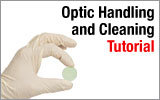

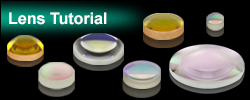
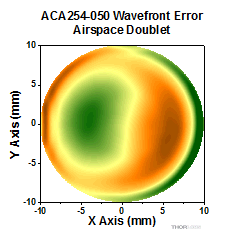

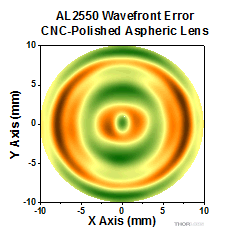
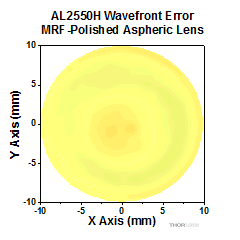

 Diffraction-Limited Aspheres
Diffraction-Limited Aspheres